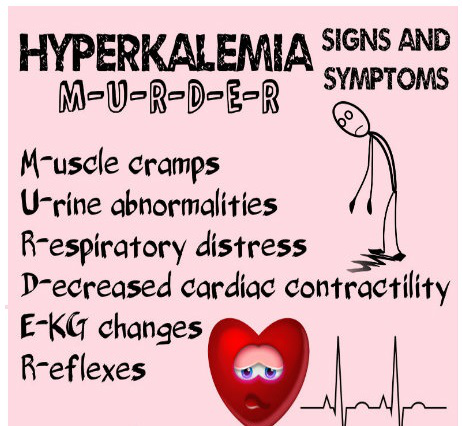Why extremely high levels of potassium in blood can kill your patient?
Abnormalities of blood potassium levels can cause a wide variety of signs and symptoms depending on how high or low the levels are. But in this post, i'll focus on the fatal effect of extremely high potassium levels only.

image from http://qa.virinchihospitals.com/livehealthy/symptoms/high-potassium-hyperkalemia
First of all we need to recall that, we have a very, very high concentration of potassium ions inside ALL our body cells compared to the outside environment, i.e. the blood plasma and the interstitial fluid.
But for now we'll focus only on the cardiac cells. (Cardiac cells, heart cells, cardiac myocytes are all synonymous).
First let's quickly understand two terms : depolarization and re-polarization. To talk about these two in detail will take a whole post on it's own, but i'll link down to some articles explaining depolarization and re-polarization if you're interested.
But for the sake of today's topic, all we need to know is, depolarization causes the heart muscles to contract, and thus pump out the blood all over the body. But after that, the heart needs to fill with blood again before it can pump again. To refill, the heart muscles must relax and the process of re-polarization causes relaxation of the heart muscles allowing it too fill and maintain it's function. Every depolarization and re-polarization is one heart beat. So if your heart is beating at a rate of 72 per minute, it means your heart cells are depolarizing 72 times and re-polarizing 72 times per minute.
On the membrane of the cardiac myocytes, we have some proteins called ungated potassium channels. These channels are always open and a potassium efflux (potassium leaving the cell) is always maintained to prevent too much potassium from accumulating and staying inside the cells.
We also have some voltage-gated potassium channels, which opens during repolarisation of the cardiac myocytes and are closed when the heart myocytes are depolarizing.
This is a snapshot from Kaplan Physiology for the USMLE Step 1.
We'll focus on two phases, phase 0 and phase 3. Phase 0 is the depolarization phase and is brought on by the influx of sodium ions via sodium channels. And phase 3 is our re-polarization, which happens due to the efflux of potassium ions from the cells to the outside via the voltage-gated and non-gated potassium channels.
It is very important to understand, why potassium is able to leave the cell so effectively and repolarize and thus relax the heart muscles : We have a very, very high concentration of potassium ions inside ALL our body cells compared to the outside environment, i.e. the blood plasma and the interstitial fluid. Thus by simple logic and understanding of concentration gradients, we can easily understand why potassium ions move in the outward direction.
But what if the concentration of potassium outside the cell, in the blood and interstitial fluid was to suddenly increase to very, very high levels? What do you think is gonna happen?
Exactly!! The potassium ions from inside the cardiac myocytes will now no longer be able to exit and re-polarize the cells. The cardiac myocytes will not be able to relax anymore and enter a permanently contracted state, which will eventually lead to death of the patient, owing to the fact that the heart is not being able to supply blood to all the vital organs. This is why we should always be aware of our patient's potassium levels at all times and make sure to prevent occurrences of such extreme hyperkalemia.
Sources :
Kaplan Physiology for USMLE Step 1, 2017
http://www.pathophys.org/physiology-of-cardiac-conduction-and-contractility/
If you enjoy medical topics, or health tips, please make sure to follow me at @simplifylife
Peace!!

